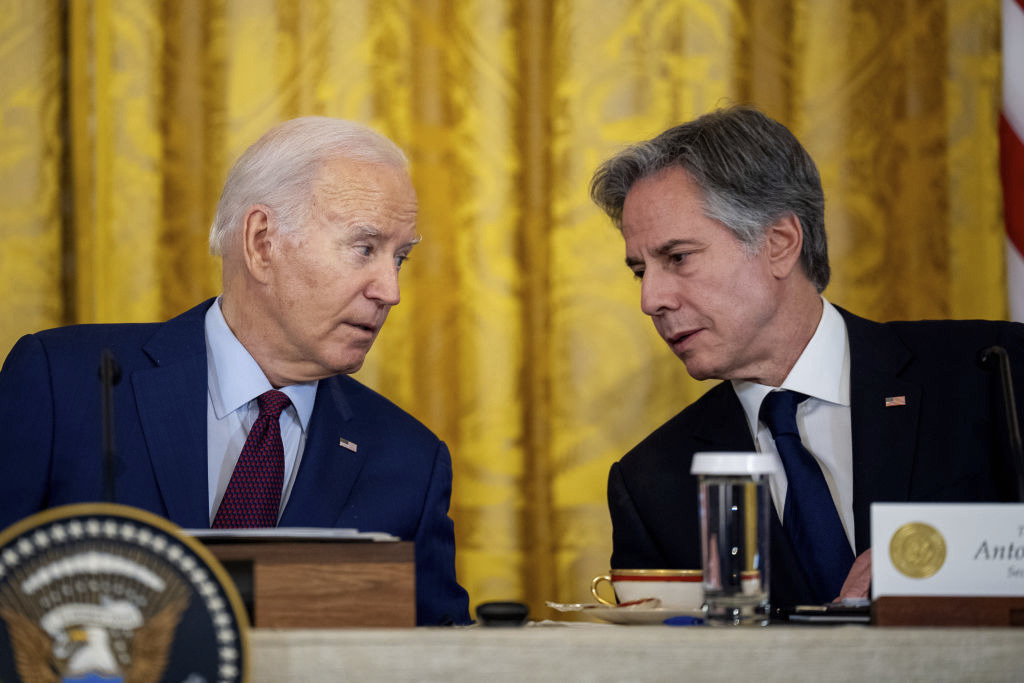gatestoneinstitute.org – US Secretary of State Antony Blinken says Hamas has been so degraded that it won’t be able to repeat the October massacre against Israel.
Maybe.
The Biden plan is part of a pattern of the US behaving as a terzo incomodo [third wheel] in vaudeville, a bothersome third party crashing into a twosome quarrel to prevent a clear outcome and foment confusion to its own advantage.
The US, often with support from the usual suspects including the United Nations and European “allies” did just that in all wars between Israel and its Arab neighbors, thus preventing war from doing its work, which is establishing a victor and a vanquished. The cold peace between Egypt and Israel was made possible when Anwar Sadat and Menachem Begin realized that it was unwise to cherish their antagonism more than the object of their hostility.
Islamic Revolutionary Guard Corps General Rostam-Ali Rafi’i says Biden “sent us a written message” saying Iran is right to attack Israel in revenge, but “should keep the revenge limited.”
Tehran is heating up the Lebanese front, thus helping Netanyahu claim that having “degraded” Hamas he should focus on the threat from Hezbollah.
As always by keeping the knife in the wound in the name of peace, the ultimate losers of this latest peace plan will be the Israelis and their Palestinian adversaries-cum-co-sufferers.

Barring the usual hitches in any plan related to the Israel-Palestine saga, what Washington is marketing as Biden’s peace proposal may soon well become reality.
Presented in the classical style of a diplomatic plan, the proposal suggests three phases for its implementation.
In the first phase a six-week ceasefire, described as “full and complete” will be installed with Israeli forces withdrawing from “populated areas” of Gaza. It is not clear why should a ceasefire need six weeks to be established. Normally a ceasefire is announced for a precise hour on a precise day at which, well, firing ceases. The adjectives “full and complete” are also redundant, since a partial and incomplete ceasefire isn’t one.
The phrase about Israeli forces leaving “populated areas” is equally open to interpretation, including misinterpretation. Almost all of Gaza’s populated areas have been turned into piles of rubble. Today, with the exception of chunks of Rafah, which Hamas is still present in its tunnels, talking of “populated areas” could mean the whole of Gaza that is now dotted with tents, slums and other shelters of fortune.
According to the plan, “this will eventually lead to a permanent ceasefire. ” Eventually, however, could mean any length of time, including never.
Elsewhere, the plan talks of “a durable peace”. But a peace that isn’t durable is a truce, not peace. Such vague phrases assume that throughout the plan, Hamas will retain at least part of its ability to fire — otherwise why talk of a ceasefire?
The plan offers Hamas another sweetener: once firing ceases and Israel withdraws from “populated areas”, the US will flood Gaza with humanitarian aid to the tune of 600 trucks a day.
And yet the much-maligned UNRWA and most NGOs admit that their shattered network for distributing aid isn’t up to the task.
Latest aid distribution has taken place either by networks under Hamas control or by black market gangs. In the past six months, Gaza’s capacity for aid absorption has averaged between 30 and 40 trucks a day. It is not clear who will check the aid that President Biden wishes to flood into Gaza. Excluding both Israel and Hamas from aid supervision and distribution could mean chaos and violence.
The six-week shibboleth may have not been snatched from thin air.
Once it becomes operational, say by the end of this month, it would cover a crucial period for President Biden’s Democrat Party to hold its national convention in Chicago (19-22 August) free of pro-Hamas students inspired by the Chicago riots of 1968 that pushed the Democrats out of the White House for eight years.
The second phase of the plan promises “a permanent cessation of hostilities”, opening the way for a third phase designated as “reconstruction”. It will also provide facilities for release of Israeli hostages still alive and remains of those who have died in exchange for Hamas prisoners in Israel.
Paradoxically, the Biden plan makes it clear that Hamas shall have no role in shaping the future of Gaza in the third phase but should cooperate in the first two phases. In other words, the turkey should help set up the Christmas dinner knowing it would be on the table, not at it.
US Secretary of State Antony Blinken says Hamas has been so degraded that it won’t be able to repeat the October massacre against Israel.
Maybe.
Hamas used around 1,300 men out of a total of 35,000 fighters in the October attack. Israel claims it has “taken out” around 10,000 Hamas fighters, although various fact-checking efforts, including by the BBC, show far lower numbers. Hamas and its sympathizers claim that 36,000 Gazans have been killed, and further claim that 90 per cent of them non-combatants, mostly women and children.
The term “degraded” was used in 2009 to justify another US-brokered ceasefire in Gaza.
The Biden plan is part of a pattern of the US behaving as a terzo incomodo (third wheel) in vaudeville, a bothersome third party crashing into a twosome quarrel to prevent a clear outcome and foment confusion to its own advantage.
The US, often with support from the usual suspects including the United Nations and European “allies” did just that in all wars between Israel and its Arab neighbors, thus preventing war from doing its work, which is establishing a victor and a vanquished. The cold peace between Egypt and Israel was made possible when Anwar Sadat and Menachem Begin realized that it was unwise to cherish their antagonism more than the object of their hostility.
The Biden plan may help the various protagonists in this tragedy temporarily solve their problems. Biden could have his convention and, beyond that, his re-election campaign, free of pressure from the pro-Hamas wing of his party. Hamas could hope to escape total annihilation.
Israeli Prime Minister Benjamin Netanyahu could have his invitation to Washington, perhaps to address the Congress. Biden may succeed in unseating Netanyahu with indirect help from Iran’s “Supreme Guide” Ali Khamenei, whose Foreign Minster Ali Baqeri Kani says Tehran is “in regular contact” with Washington to help end the war in Gaza.
Islamic Revolutionary Guard Corps General Rostam-Ali Rafi’i says Biden “sent us a written message” saying Iran is right to attack Israel in revenge, but “should keep the revenge limited.”
Tehran is heating up the Lebanese front, thus helping Netanyahu claim that having “degraded” Hamas, he should focus on the threat from Hezbollah.
The Israeli left may hope to see the current right-wing coalition in disarray, giving the badly battered left another chance.
Who knows, there may even be a couple of Nobel Peace Prizes for the regional cheerleaders for the “Biden Peace Plan.”
As always, by keeping the knife in the wound in the name of peace, the ultimate losers of this latest peace plan will be the Israelis and their Palestinian adversaries-cum-co-sufferers.
That the plan has been received with a sigh of relief across the world is no surprise.
Nightly if not hourly, images of death and destruction have pushed public opinion to the limits of toleration. Palestine has become “the cause”, or in the words of Ayatollah Khamenei “the number one concern of all mankind”, the chief vehicle for virtue-signaling and an all-encompassing excuse for the failure of political elites across the globe.
Palestine is the talisman of the great expurgation. The Biden Plan will help keep it intact for future use and abuse.
Amir Taheri was the executive editor-in-chief of the daily Kayhan in Iran from 1972 to 1979. He has worked at or written for innumerable publications, published eleven books, and has been a columnist for Asharq Al-Awsat since 1987. He is the Chairman of Gatestone Europe.
This article originally appeared in Asharq Al-Awsat and is reprinted with some changes by kind permission of the author.
 Shabtabnews In this dark night, I have lost my way – Arise from a corner, oh you the star of guidance.
Shabtabnews In this dark night, I have lost my way – Arise from a corner, oh you the star of guidance.



